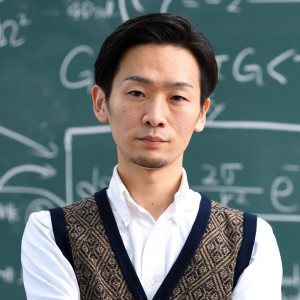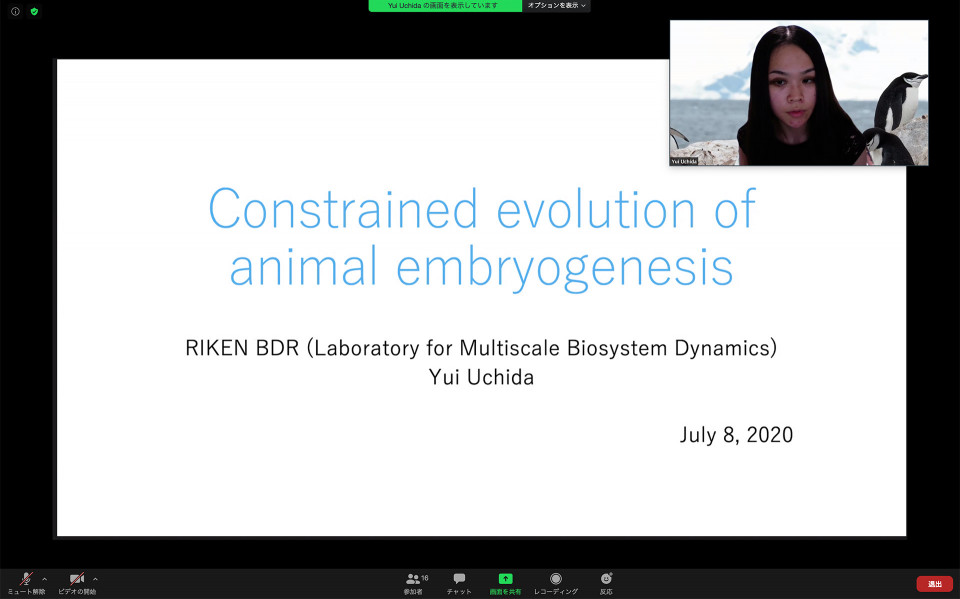Volume 111
Back to Newsletter List
Press Release
Black Hole as a Quantum Field Configuration
2020-07-09
A joint research team led by Yuki Yokokura, a senior researcher at the Interdisciplinary Theoretical and Mathematical Sciences Program at RIKEN, has theoretically described the interior of an evaporating black hole using quantum mechanics and general relativity.
The results of this research will provide an insight into the nature of black holes, and are expected to provide a basic theory of "black hole engineering" that will utilize black holes as devices to store information in the distant future.
The study was published in the online scientific journal Universe on June 4.
Reference
- Hikaru Kawai and Yuki Yokokura, Black Hole as a Quantum Field Configuration, Universe 6(6), 77 (2020), doi: 10.3390/universe6060077
Seminar Report
Biology Seminar by Dr. Yui Uchida on July 8, 2020
2020-07-08
On 8th July, Ph.D. Yui Uchida (RIKEN BDR) gave a talk at the iTHEMS Biology Seminar. Dr. Uchida introduced to us the research field of Evolutionary Developmentary biology (EvoDevo) and talked about her researches on embryogenesis. Her lecture gave a briefly explanation about the background of EvdDevo in general and the important evolutionary questions in vertebrate development that had been tackled by her with mathematical modeling of embryogenesis. I felt her lecture helped many audiences to understand EvoDevo and we had a good discussion. Another highlight of her talk was her talk on the evolution of the five fingers of Tetrapoda excited the physicists! Thank you very much, Dr. Uchida.
Constrained evolution of animal embryogenesis
July 8 (Wed) 10:00 - 11:00, 2020
Upcoming Events
Seminar
iTHEMS Theoretical Physics Seminar
Complex Langevin study of an attractively interacting two-component Fermi gas in 1D with population imbalance
July 10 (Fri) 13:30 - 14:30, 2020
Shoichiro Tsutsui (Special Postdoctoral Researcher, Quantum Hadron Physics Laboratory, RIKEN Nishina Center for Accelerator-Based Science (RNC))
We investigate an attractively interacting two-component Fermi gas in 1D described by the Gaudin-Yang model with population imbalance. While the Gaudin-Yang model is known as a solvable model based on the thermodynamic Bethe ansatz, the binding energy and mass of poralon at finite temperature and moderate impurity density are still unknown. Moreover, in such a system, quantum Monte Carlo simulation suffers from the sign problem because the population imbalance makes the fermion determinant non-positive definite. In this study, we apply complex Langevin method, a holomorphic extension of the stochastic quantization to overcome the sign problem. We first confirm our numerical results satisfy a criteria for correct convergence [1], and present how the polaron energy depends on temperature and density of impurity. We also compare our results with a recent study based on a diagrammatic approach [2].
References
- K. Nagata, J. Nishimura, S. Shimasaki, Phys. Rev. D 94, 11 (2016).
- H. Tajima, S. Tsutsui, T. M. Doi, arXiv:2005.12124
Venue: via Zoom
Event Official Language: English
Seminar
DMWG Seminar
Search for ultralight dark matter with laser interferometric gravitational wave detectors
July 13 (Mon) 10:00 - 11:00, 2020
Yuta Michimura (Assistant Professor, Department of Physics, Graduate School of Science, The University of Tokyo)
Venue: via Zoom
Event Official Language: English
Seminar
iTHEMS Biology Seminar
Application of geometry to protein structure analysis
July 15 (Wed) 14:00 - 15:00, 2020
Haru Negami-Oono (Ph.D. Student, Institute for Biology and Mathematics of Dynamic Cellular Processes, The University of Tokyo)
Geometry is applied in various fields as a method for revealing the structure of data. In this seminar, I will introduce the topological method, fatgraph model, to classify protein structures. I will also introduce another related geometric model and its application to viral glycoprotein analysis. This method provides an a priori prediction of structural rearrangement of proteins.
Venue: via Zoom
Event Official Language: English
Seminar
iTHEMS Math Seminar
Topological data analysis from a practical and mathematical perspective
July 15 (Wed) 16:00 - 18:10, 2020
Yuichi Ike (Researcher, Artificial Intelligence, FUJITSU LABORATORIES LTD.)
1. Topological data analysis and its applications
In this talk, I will explain some methods in topological data analysis (TDA) and their applications. First I recall persistent homology, which is a central tool to analyze the "shape" of a point cloud set. Then I show several applications to material science and time-series analysis. I also talk about our collaborative research with Inria on noise-robust persistent homology and an automated vectorization method of persistence diagrams.
2. Persistence-like distance on sheaf category and displacement energy
In this talk, I will talk about relation among sheaf theory, persistence modules, and symplectic geometry. We introduce a persistence-like distance on Tamarkin sheaf category and prove a stability result with respect to Hamiltonian deformation of sheaves. Based on this result, we propose a new sheaf-theoretic method to give a lower bound of the displacement energy of compact subsets of a cotangent bundle.
This is a joint work with Tomohiro Asano.
Venue: via Zoom
Event Official Language: English
Colloquium
MACS ColloquiumSupported by iTHEMSSUURI-COOL (Kyoto)
The 12nd MACS Colloquium
July 17 (Fri) 15:00 - 18:30, 2020
Yasuaki Hiraoka (Professor, Kyoto University Institute for Advanced Study (KUIAS) / Team Leader, Topological Data Analysis Team, RIKEN Center for Advanced Intelligence Project (AIP))
Motomu Tanaka (Professor, Physical Chemistry of Biosystems, Heidelberg University, Germany / Professor, Center for Integrative Medicine and Physics, Kyoto University Institute for Advanced Study (KUIAS))
15:00- Talk by Prof. Yasuaki Hiraoka
16:15- MACS Student Conference FY2020
17:30- Talk by Prof. Motomu Tanaka
Venue: via Zoom
Event Official Language: Japanese
Seminar
iTHEMS Biology Seminar
Human Time vs. Mouse Time in Embryonic Development
July 17 (Fri) 16:00 - 17:00, 2020
Miki Ebisuya (Group Leader, European Molecular Biology Laboratory, Barcelona, Spain)
Different species have different tempos of development: larger animals tend to grow more slowly than smaller animals. My group has been trying to understand the molecular basis of this interspecies difference in developmental time, using the segmentation clock as a model system.
The segmentation clock is the oscillatory gene expressions that regulate the timing of body segment formation during early embryogenesis. We have recently succeeded in recapitulating the segmentation clock from both human and mouse pluripotent stem cells, detecting oscillations and traveling waves in vitro. Interestingly, the oscillation period of human segmentation clock was 5-6 hours while that of mouse was 2-3 hours. Taking advantage of our in vitro system and simple mathematical models, we have been comparing the genome sequences and molecular processes of the segmentation clock between human and mouse to explain the interspecies difference in the oscillation period.
References
- Matsuda et al., “Species-specific oscillation periods of human and mouse segmentation clocks are due to cell autonomous differences in biochemical reaction parameters”, bioRxiv, doi.org/10.1101/650648 (2019)
- Matsuda et al., “Recapitulating the human segmentation clock with pluripotent stem cells”, Nature, 580 (2020)
Venue: via Zoom
Event Official Language: English
Seminar
DMWG Seminar
DMWG special seminar : “The result of the XENON1T experiment and its implications”
July 22 (Wed) 15:30 - 17:00, 2020
Masaki Yamashita (Associate Professor, Cosmic-ray Research Division, Institute for Space–Earth Environmental Research, Nagoya University)
Venue: via Zoom
Event Official Language: Japanese
Paper of the Week
Week 2 of July
2020-07-09
Title: Constraining Primordial Black Holes with Dwarf Galaxy Heating
Author: Philip Lu, Volodymyr Takhistov, Graciela B. Gelmini, Kohei Hayashi, Yoshiyuki Inoue, Alexander Kusenko
arXiv: http://arxiv.org/abs/2007.02213v1
Title: On origami embeddings of flat tori
Author: Takashi Tsuboi
arXiv: http://arxiv.org/abs/2007.03434v1
If you would like to cancel your subscription or change your email address,
please let us know via our contact form.
Copyright © iTHEMS, RIKEN. All rights reserved.





